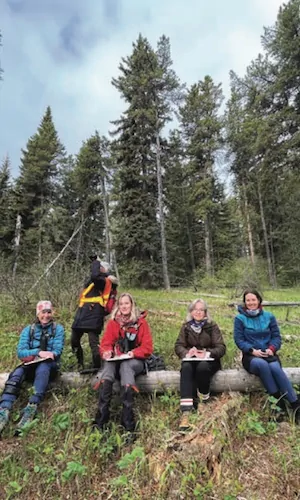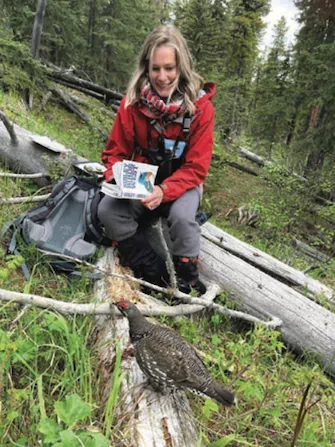2024 BCEC BIRD SURVEY – PROPOSED CUTBLOCKS

It takes a certain dedication from volunteers to agree to rise before dawn, and bush-whack through dense forest for six hours, spending much of the time in silence! That’s what a team of local bird enthusiasts did on June 9th to complete a Point Count nesting bird survey in a proposed clearcut block in the West Bragg Creek Trails system in East Kananaskis.
After months of planning, reconnaissance, preparation and training, the team – under the guidance of biologist Kelly Day and BCEC project-leader Emma Barry – set off at 4:30am to Fullerton Loop trailhead.
The early start was necessary to catch the optimal time window for bird counting: predawn to 10 or 11 am. After that male birds, who sing enthusiastically to attract mates, quiet down for the day.
BCEC chose Fullerton Loop because West Fraser Cochrane (WFC) intends to clear-cut the entire centre of that trail in 2026. We aim to create a baseline record of nesting birds in the proposed cut blocks, in particular Species at Risk (SAR). By knowing what we have now, we will know what we stand to lose.
To ensure the data collected will be recognized by governments and experts, we adhered to ESRD (Environmental and Sustainable Development) guidelines for Boreal and Foothills Breeding Songbirds and Woodpeckers as laid out by the Government of Alberta, Wildlife Management-Sensitive Species Inventory Guidelines. This included meeting clear survey standards such as experienced observers, correct time of year, correct time of day, appropriate weather conditions and so on. Survey protocols include using the Point Count method and auditory recordings.
Using the Avenza Map App, the Merlin Bird ID App, sophisticated audio recording equipment, Point Count data sheets, binoculars, compass, and Kelly’s guidance, the group set out. We covered nearly every meter of the proposed Fullerton Loop clear cut block, completing seven Point Count surveys, and many more incidental sightings. We recorded over 18 species, including two incidences of Black Throated Green Warbler, and one of Brown Creeper (both SAR).

At the deepest point in the dense forest we were joined by a gorgeous male Spruce Grouse. He purred, clucked and strutted, clearly fascinated. He followed along and settled in with us for the duration of the silent Point Count, tucking down onto a log beside one of the birders. He was dubbed a mascot, and more than that, an emissary… a representative of our feathered relatives, encouraging the important work being done.
Since the 1970’s, the North American bird population is down by 2.9 billion breeding adults, across every biome. John Fitzpatrick – director of The Cornell Lab, a leading research institute for the study of birds – qualifies these results of recent research as “a staggering loss that suggests the very fabric of North America’s ecosystem is unravelling.” The study goes on to paint a grim picture, with even birds considered common suffering great losses: Dark-Eyed Juncos are down by 168 million, Redwinged Blackbirds by 92 million.*
For us, it’ll take some time to complete the post-survey data analysis and create a spreadsheet representing the survey work. Once it’s complete we’ll share the bird count information with our community, other conservation groups, trail stewards, all levels of government, WFC and the media. In the meantime, the BCEC birder group is planning for a follow-up bird survey on June 22, and strategizing for the effective dissemination of the data we’ve collected.
In addition to the urgency of understanding the natural assets in the proposed cut blocks, BCEC is committed to adding to scientific data records over the long term. Our vision is to expand the spring bird count in the West Bragg Creek and East Kananaskis areas in the coming years. Stay tuned to hear more about those plans, and how you can participate.
You can also help support healthy bird populations anytime by following these suggestions from the Cornell Lab (see their website for more):
- Make windows safer – Up to 1 billion birds are estimated to die each year after hitting windows in the United States and Canada
- Keep cats indoors – Outdoor cats kill more birds than any other non-native threat
- Reduce lawn by planting native species – increase the amount of food and shelter available to birds where you live
- Avoid pesticides – they are often toxic to us, as well as to birds
- Reduce use of plastics wherever possible – 91% of plastics are not recycled, and they take 400 years to degrade.*
- And most importantly, get out and listen/look for the birds. Learn bird calls and share what you discover. Contribute to bird reports what you discover.
Contact us if you want to find out more or to join in with our important citizen science based work.
Check us out at braggcreekenvironmentalcoalition.ca
Contact us at info@ braggcreekenvironmentalcoalition.ca
*https://www.birds.cornell.edu/home/bring-birds-back/

























